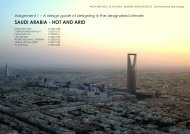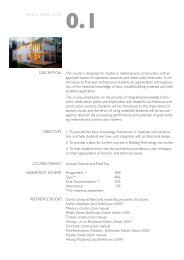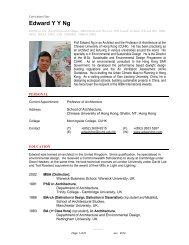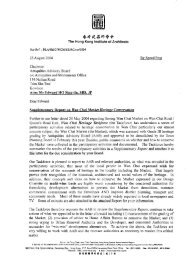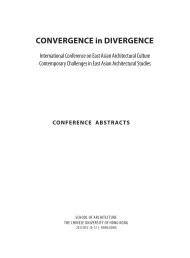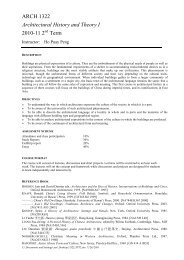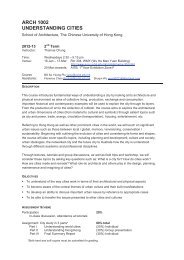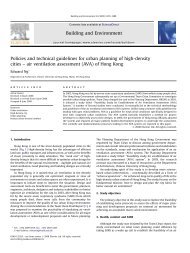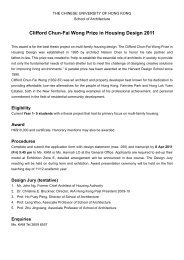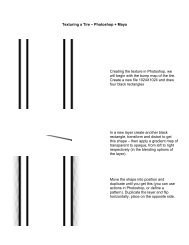Shopping Mall as Privately Owned Public Space - School of ...
Shopping Mall as Privately Owned Public Space - School of ...
Shopping Mall as Privately Owned Public Space - School of ...
- No tags were found...
You also want an ePaper? Increase the reach of your titles
YUMPU automatically turns print PDFs into web optimized ePapers that Google loves.
SHOPPING MALL AS PRIVATELY OWNED PUBLIC SPACEPhenomenaPrivatization <strong>of</strong> public realm in Hong KongSince the Hong Kong government triesto improve the urban environmentby providing public spaces in privateproperties, developers are encouragedto provide extra public spaces in theircould be exempted. Privatization <strong>of</strong> publicspaces seems to be the trend <strong>of</strong> urbandevelopment in high-density city like HongKong. On paper, this idea makes sense.However, how public are those “publicspaces”? Most <strong>of</strong> them are inaccessible forpublic and our rights are restricted in thoseare<strong>as</strong>. In response to the failure <strong>of</strong> many <strong>of</strong>those spaces, we have to reconsider thisapproach and reinvent this kind <strong>of</strong> spacesby regaining publicity <strong>of</strong> public spaces thatcan truly promote public life in our city.Thesis statementThis thesis will investigate the possibility<strong>of</strong> using privatized public spaces <strong>as</strong>design strategy for shopping complex,by integrating civic functions and retailsto create a new type <strong>of</strong> public realm totransform the city. It provides an alternativetemplate <strong>of</strong> urbanization b<strong>as</strong>ed on theprocess <strong>of</strong> hybridization <strong>of</strong> malls, civicprograms and public spaces, enriching thecity’s public <strong>of</strong>fering by extending publicsectors in private properties.Background Research1. Development <strong>of</strong> shopping in Hong KongThe development <strong>of</strong> shopping w<strong>as</strong>new town developments since 70s and theintroduction <strong>of</strong> podium & ComprehensiveDevelopment Area (CDA). Those policieshad great impacts on architectures<strong>of</strong> shopping in terms <strong>of</strong> organization,complexity and bulkiness.2. <strong>Shopping</strong> <strong>as</strong> contemporary lifeThis part <strong>of</strong>research is goingto analysis thefactors enhancingconsumer culturein HK <strong>as</strong> city <strong>of</strong>shopping. <strong>Shopping</strong>malls have mergedto residentialand railwaydevelopments, the change in form <strong>of</strong> livingand the development <strong>of</strong> railway shorten thedistance from our home to shopping malls,encouraging the consumption activities indaily life. On the other hand, people preferto stay at indoor area because <strong>of</strong> hot andhumid environment in Hong Kong, thisalso enhances the role <strong>of</strong> mall <strong>as</strong> the mostfavourite gathering place.3. Typology study:Studying and comparing different types <strong>of</strong>shopping architecture in terms <strong>of</strong> scale,circulation, accessibility, openness andpermeability in relation <strong>of</strong> its publicness.ThesisAbstractWhat is “<strong>Public</strong> <strong>Space</strong>”?1. Parks VS <strong>Mall</strong>sBy comparing the restrictions in parks andspaces in contemporary city and seek ameaning <strong>of</strong> public life.2. The role <strong>of</strong>public spaces incontemporary cityThe decline in thequality <strong>of</strong> publicspaces indicatesthat we have torethink the role <strong>of</strong>public spaces in ourcity. <strong>Public</strong> spacesare no longer simply functioned <strong>as</strong> urbanvoid like the lung <strong>of</strong> city. <strong>Public</strong> spacesshould be a hybrid <strong>of</strong> actual physical spacesand active public spheres, but active publicspheres require accountability to function,private corporation could be one <strong>of</strong> theaccountable bodies. <strong>Shopping</strong> malls providegood setting for public activities, on theother hand public space could act <strong>as</strong> thespatial strategy to organize the mall.Why shopping mall and open space?- <strong>Mall</strong> <strong>as</strong> city centreInvestigating the relationship betweenmall and city, shopping malls h<strong>as</strong> beentransformed from a component <strong>of</strong> city tothe prerequisite <strong>of</strong> urbanity. <strong>Mall</strong>s not onlyserve <strong>as</strong> the iconic centre <strong>of</strong> city but alsoprovide physical spaces for social activities,<strong>as</strong> a result shopping malls h<strong>as</strong> replacedevery <strong>as</strong>pects <strong>of</strong> urban life. However, citycentre should also function <strong>as</strong> a “place”,where “every body occupies its place”. Citycentre should help one to construct hisown identity and relate to himself to thehistory <strong>of</strong> that place.- Investigating the relationship betweenmalls, public spaces and cityC<strong>as</strong>e study: e.g. Namba Park in Osaka byJon JerdePotential SiteTaiwai station is proposed <strong>as</strong> experimentalsite where provide large empty spacefor development, railway provides goodinfr<strong>as</strong>tructure <strong>of</strong> transportation and stable11



